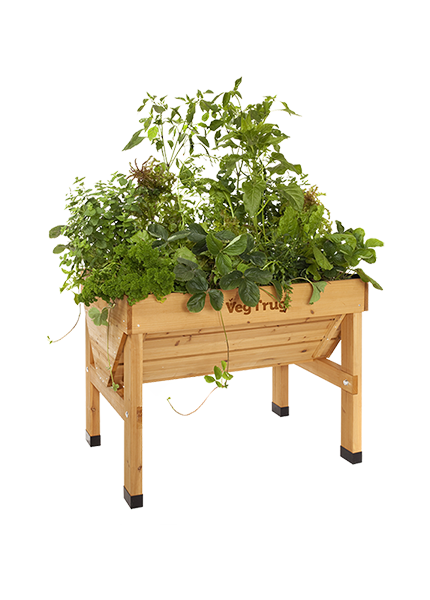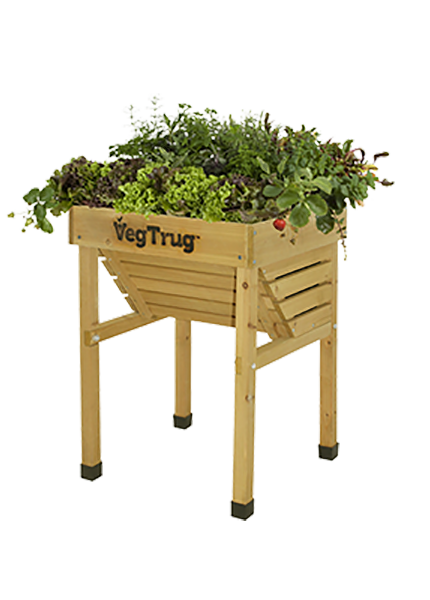Raspberries are one of the world’s most popular berries. They’re great for any size garden and grow well in a VegTrug too.
Try growing both summer and autumn varieties and you’ll enjoy a good crop of raspberries from the middle of summer and throughout the autumn.
Read more on how to grow Raspberries below.
Raspberries can be planted any time during the dormant winter season, providing the soil is not frozen or waterlogged. They are sold as either bare-root canes (the roots are exposed when you buy) or in containers.
Most people grow summer-fruiting raspberries, which are ready for harvesting in early summer. You can also buy autumn-fruiting raspberries, which are ready for harvest in the autumn.
Before planting, clear the site of perennial weeds, as these are difficult to control once raspberries are established. Dig over the site and add a bucket of well-rotted farmyard manure per square metre or yard and a general fertiliser such as Growmore or fish blood and bone at 90g per sq m (3oz per sq yard).
Space the plants around 45-60cm (18in–2ft) apart if planting in rows. Top with a 7.5cm (3in) thick mulch of bulky organic matter. Avoid alkaline mushroom compost or overly rich farmyard manure, which can burn the new shoots.
Prune the canes to within 25cm (10in) of the ground after planting. However, summer fruiting raspberries can be supplied as one year old canes (long canes). Don't prune these as they'll fruit for you that season.
Single raspberry plants can be grown in containers that are at least 38cm (15in) diameter. Mix the soil as 80 per cent multipurpose compost and 20 per cent loam-based potting compost, to add weight. Use bamboo canes to support the raspberry canes.
Keep the compost moist and feed monthly with a liquid general-purpose fertiliser during the growing season. In hard water areas try to use harvested rainwater.
Raspberries thrive in moisture-retentive, fertile, slightly acidic soils, which are well-drained and weed free. They dislike soggy soils and shallow chalky soils. For best results, plant in a sunny position (although they will tolerate part shade). Ideally, site your rows running north to south, so that they do not shade each other.
Raspberry flowers are self-fertile and pollinated by insects, so avoid a very windy site. Also, the fruiting side branches of some cultivars are very long and may break in the wind.
In early spring, sprinkle a general-purpose fertiliser such as Growmore around the base of the plants, then add a mulch of garden compost or well-rotted farmyard manure. This will prevent weeds growing. Keep raspberries well-watered during dry periods.
Once you know how to grow raspberries you can enjoy a season of tasty fruit.
In early summer, pull up suckers between the rows of summer raspberries. Cut back fruited canes to ground level after harvesting in summer; do not leave old stubs.
Select the strongest young canes that have grown during the current season, around six to eight per plant, and tie them in 8 –10cm (3–4in) apart along the wire supports. These will fruit for you the following summer.
Remove the remaining (excess) young stems to ground level.
Cut back all the old, fruited canes to ground level in February. New canes will start growing in spring. These will bear fruit for you later in the year.
Reduce the number of canes slightly in summer if they are very overcrowded. Thin to around 10cm (4in) apart.
Birds, pigeons in particular, love the fruit and leaves from raspberries. Netting, or a VegTrug cover, can be effective in preventing your plants being attacked.
But probably the biggest issue facing raspberries is the raspberry beetle. The fruit or stalks will show dry patches and you’ll likely see a white maggot inside the emerging berries.
Removing the affected berries can slow down the spread but will not eradicate it.
You might also come across a couple of fungal diseases when learning how to grow raspberries.
Raspberry cane blight and raspberry spur blight attack the plant’s cane, but the former is more serious. Raspberry cane blight sees the leaves wither and the cane darken and turn brittle.
With raspberry spur blight won’t kill the plant but can weaken the plant so you’ll get less fruit.
In both cases keep the air circulating and cut out the affected parts. With raspberry cane blight cut the affected canes back to ground level. Disinfect any tools.
As soon as your raspberries are full and ripe, pick and use them fresh. When ripe, they should be succulent, full of colour and easy to pick. If you get too many, they can be easily frozen too.
How to grow raspberries is part of the VegTrug Grower’s Guide.

